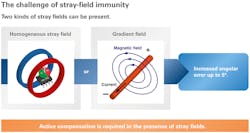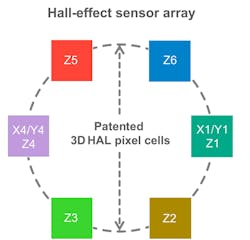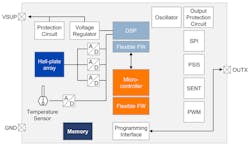The electric-vehicle market continues on a serious upswing: Allied Market Research predictsForecasts show it will reach $802.81 billion by 2027, up from $162.34 billion in 2019. Such growth also pushes the need for additional magnetic field sensors within these vehicles for position detection. The sensors are robust enough to withstand a variety of harsh environmental conditions, temperatures, vibrations, and water and dust.
However, the accuracy of these sensors may be negatively affected by stray magnetic fields caused by other magnetic components and stray magnetic fields in their surrounding environment. This presents significant design challenges for engineers.
Stray Magnetic Fields
Though electric starter motors have been used in vehicles for more than 100 years, it wasn’t until the 1960s that an electrical alternator was standard for production cars. The adoption of these parts in most vehicles was quick and has led to more and more electric parts within vehicles. Now, electric systems have replaced various mechanical and hydraulic systems, and are commonplace in conventional automobiles because they increase vehicle efficiency.
Sensors are crucial to improving efficiency and extending the functionality of electronic systems in vehicles. In conjunction with actuators, these sensors form an interface between the vehicle and an electronic control unit (ECU) to detect a system status and input data for the control units. These control units run the algorithms for controlling and regulating each electronic system, triggering the electrical signals for the actuators used to turn electrical signals into mechanical movements.
In a 12-V system, auxiliary systems in the vehicle, including electronic power-assisted steering, produce high currents and consequently generate stray magnetic fields that can negatively impact sensors and other systems. In addition, the electric motors and power-supply cables in hybrid and electric vehicles (HEVs and BEVs) also produce unwanted stray magnetic fields. These stray magnetic fields can decrease the accuracy of magnetic-field sensors.
A distinction is made between homogenous and non-homogenous stray magnetic fields, also called gradient fields. A stray magnetic field is considered homogenous if the field lines are consistent, point in the same direction, and are equidistant from one another. This results in a magnetic flux density that’s the same across a specifically defined area.
Helmholtz coils are used to generate homogenous stray magnetic fields and carry out robustness tests, whereas a power-supply cable or other current-carrying wire will create a non-homogenous stray magnetic field. In this case, the stray magnetic field is stronger, more disruptive, and erratic when close in proximity to the wire.
In addition, non-homogenous stray magnetic fields can be produced by adjacent sensor systems, which use a permanent magnet as a transmitter. Stray magnetic fields can cause sensors to significantly—and dangerously—malfunction, and lead to increased measurement errors of up to 5 degrees.
Minimizing Impact
To combat interference from these stray magnetic fields, most manufacturers stipulate strict guidelines, including adherence to ISO Standard 11452-8. These guidelines specify tests for electromagnetic immunity of electronic components for passenger cars and commercial vehicles that demonstrate a high level of immunity against interference in the low-frequency range with a magnetic field strength of 4000 A/m (about 5 milliteslas, or mT). In the previous version of the ISO 11452-8 standard, only stray magnetic fields of around 1.2 mT were used as interference.
For weaker stray magnetic fields, it was often sufficient to tune the magnets used for the application to the strength of the stray magnetic field, or to implement a complex magnetic shield. However, this was costly, and research demonstrates that smaller magnets may be used for shields. In either case, active stray-field compensation for magnetic-field sensors is essential.
Certain Hall-effect sensors, such as the Micronas HAL 39xy product family from TDK, significantly reduce interference from stray magnetic fields. This new type of Hall-effect sensor, designed to ensure extremely precise measurement of magnetic fields, is unaffected by stray magnetic fields. The unique stray magnetic-field compensation concept is based on an array of vertical and horizontal Hall plates. The newest flexible Hall-effect sensor array technology allows for more flexibility, so that design engineers can choose the most suitable stray magnetic-field compensation concept for each measuring application.
In the case of the above-mentioned sensor, each measuring mode uses a different combination of Hall-effect plates for optimal performance. It combines all four measuring modes in a single compact sensor rather than multiple components
Homogenous stray magnetic fields can be suppressed using just a two-pole magnet for linear position detection and full 360-degree angle measurement. For 180-degree angle measurement, a four-pole magnet may be used, suppressing gradient fields. In each case, these new technological advances comply with ISO 11452-8—the stray magnetic fields are deducted and the angle is calculated within the integrated digital signal processor (DSP) of the sensor.
Additional Automotive Applications
Requirements for stray magnetic-field compensation and for safety of electronic vehicle systems (ISO 26262) are becoming increasingly rigorous. Many of these outline strict safety requirements for autonomous driving so that the sensor continues to work safely even in the event of a fault or failure. As a result, it’s crucial for engineers to specify Hall-effect sensors that have been developed according to ISO 26262 to support Functional Safety applications. These include brake-pedal position detection, shift position, exhaust gas recirculation systems, and more.
Vehicle braking systems illustrate the absolute importance of immunity to stray magnetic fields. Such systems are also changing due to the adoption of more and more electric components in automobiles.
For example, many hybrid and electric vehicles recover energy through regenerative braking and automatic independent brake intervention, which can significantly increase energy efficiency and safety, respectively. These systems may use an electric motor in the place of a typical vacuum brake servo. The motor utilizes a gearbox to drive a hydraulic piston, combining the function of the brake servo when the pedal is pressed and the traction control system for active pressure generation.
To detect the driver’s intention to brake, the brake pedal must be monitored using a position, pressure, and speed measurement. The brake pedal is decoupled from the pressure generator in the process. Information regarding the angle of the pedal is transmitted electronically to the integrated ECU; the electric motor calculates the intended deceleration and generates the brake pressure. This ECU operates in a way whereby most drivers are unaware of the transition between regenerative braking and the mechanical friction braking in hybrid and electric vehicles.
The position detector must function correctly at all times—even when affected by stray magnetic fields—to meet the high safety requirements demanded by regulatory bodies and consumers. The electric motors in the newest generation of braking systems generate electric currents; therefore, stray magnetic fields must be compensated so that the position detector isn’t compromised.
The range of the rotational angle for brake pedals is 15 to 20 degrees, and the angle error resulting from stray magnetic fields with conventional magnetic sensors may reach 5 degrees. As a result, ECUs may not be able to correctly process the position information. Consequently, it’s crucial that the sensor is immune and unaffected by stray magnetic fields.
Because sensors can be used in all kinds of systems, valves, and actuators in electric vehicles, their accuracy is critical, and they must be unaffected by stray magnetic fields. Hall-effect sensors offer one of the best solutions to significantly reduce interference from stray magnetic fields.
*Note: HAL 39xy uses licenses of Fraunhofer Institute for Integrated Circuits IIS
Frederik Berstecher is Product Marketing Manager for 3D Position Sensors at TDK-Micronas.



